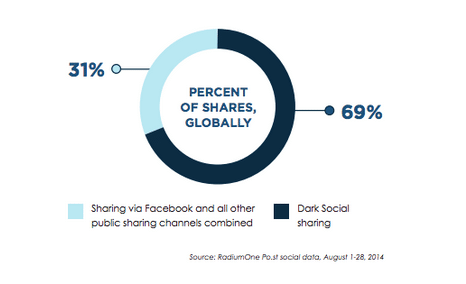Is 2015 The Year Dark Social No Longer Leaves Us In The Dark?
We’ve all done it. You find a link to an interesting article or funny video you’ve seen online and decide to share it with a friend through email, Instant Messenger or SMS. This is classed as dark social. The reason it’s dark is because it isn’t tracked by conventional web analytics platforms.
It’s a lot more common than you think. A Radium One study recently reported that nearly 70% of online referrals now come from dark social.
To put the previous sentence into context, Facebook is the largest social network in the world, connecting nearly 1.4B internet users. Together its users share an estimated 4 billion pieces of content every single day. However, Facebook only accounts for about 20% of overall sharing, according to Po.st data.
So with such a large percentage of sharing not being measured, how can marketers really know what’s going on? With such a vast amount of social traffic essentially invisible to most analytics programs, an alternative approach needs to be considered in order to more accurately quantify your marketing efforts.

While social platforms try their best to quantify their campaigns by using UTM codes – small codes attached to the end of URLs – there’s no simple way of capturing it all clearly.
But while coming up with a way to track this unrecorded sharing activity continues to give marketers some sleepless nights, one thing’s for sure: dark social is one of the most exciting marketing opportunities around.
Now 69% is a huge percentage, but it’s not purely the number of shares that makes dark social so appealing – it’s the sorts of people who dark social content is shared with.
Content shared in this way tends to be directed to close friends, family members and colleagues. In a marketer’s eyes, your most valuable acquaintances are often part of their bullseye audience.
Therefore dark social sharing carries much more value than a broadcast Facebook post or Tweet, which could be easily be missed among the hordes of other content vying for people’s attention when they login to any platform. Savvy brands simply can’t afford to keep measuring only the tip of the social iceberg and claiming they’ve got the full picture.
And don’t be fooled into thinking this vast copy and paste culture only refers to desktop users. Texts, SMS, messenger services like Whatsapp or Telegram are also heavily used.
It all counts. According to Ovum, in 2015 a staggering one billion people will use their mobile phone as their only online internet connected device. As a mobile-first approach to connectivity continues to develop, dark social sharing can only continue to grow at an exponential rate. But how do marketers make the most of dark social?
Here are some tips:
Don’t Hide, Attempt To Quantify

Dark social doesn’t have to remain social media’s ‘D’ word. Stop settling for the easy-to-come-by analytics and get your data spotlight out. There’s data to be mined and it’ll allow you to accurately depict social ROI instead of just scraping the outer layers. Google Analytics can’t give you all the answers, but your direct traffic is a good place to start. Look for URLs that look like humans wouldn’t naturally use or in fact remember. People don’t type out long, complex links into browsers, therefore these are a strong sign of dark social referrals.
Utilize Technology To Make Your Data Work For You

These days marketers are overrun with data. In fact, 90% of all the data in the world has been generated over the last two years, and this isn’t going to slow as consumption habits only increase. Segments in Google Analytics are designed to help you cut the data in ways most useful to you. Create a data segment using filters to look specifically at direct traffic. You’re looking for new users who come to your site on a page that is not the homepage. These can be can also be classed as dark social referrals on the assumption that users will not remember a long or complex URL to type into a browser.
Quick Start With UTM Parameters

While there are premium tools out there to help you on your quest, budgets don’t always allow. So look to small things to begin to quantify the volume. Budgets are a lot easier to come by when you’ve got data backing up your case. UTM parameters is an easy place to start. A unique code attached to the end of your URLs which can then be measured. Now some users could remove this, but most won’t even notice it. Services like Tynt do a pretty good job here and are easy to get up and running.
[pardot-form id=”4852″ title=”Whitepaper & Insight Sign Up”]
